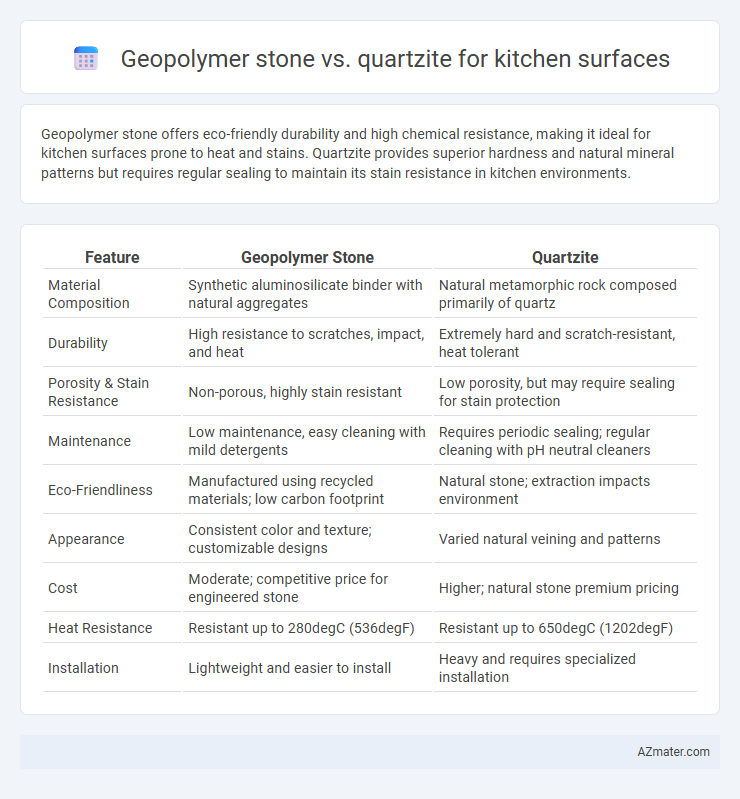Geopolymer stone offers eco-friendly durability and high chemical resistance, making it ideal for kitchen surfaces prone to heat and stains. Quartzite provides superior hardness and natural mineral patterns but requires regular sealing to maintain its stain resistance in kitchen environments.
Table of Comparison
| Feature | Geopolymer Stone | Quartzite |
|---|---|---|
| Material Composition | Synthetic aluminosilicate binder with natural aggregates | Natural metamorphic rock composed primarily of quartz |
| Durability | High resistance to scratches, impact, and heat | Extremely hard and scratch-resistant, heat tolerant |
| Porosity & Stain Resistance | Non-porous, highly stain resistant | Low porosity, but may require sealing for stain protection |
| Maintenance | Low maintenance, easy cleaning with mild detergents | Requires periodic sealing; regular cleaning with pH neutral cleaners |
| Eco-Friendliness | Manufactured using recycled materials; low carbon footprint | Natural stone; extraction impacts environment |
| Appearance | Consistent color and texture; customizable designs | Varied natural veining and patterns |
| Cost | Moderate; competitive price for engineered stone | Higher; natural stone premium pricing |
| Heat Resistance | Resistant up to 280degC (536degF) | Resistant up to 650degC (1202degF) |
| Installation | Lightweight and easier to install | Heavy and requires specialized installation |
Introduction: Geopolymer Stone vs Quartzite
Geopolymer stone offers a sustainable, non-toxic alternative to traditional natural stones, featuring high durability and resistance to heat and stains, which makes it ideal for kitchen surfaces. Quartzite is a natural metamorphic rock known for its hardness, scratch resistance, and unique veining patterns, commonly chosen for its aesthetic appeal and long-lasting performance in kitchen countertops. Comparing Geopolymer stone and quartzite involves evaluating factors such as environmental impact, maintenance requirements, cost, and overall durability under kitchen conditions.
Composition and Formation
Geopolymer stone is an engineered material composed of aluminosilicate minerals combined with alkaline activators, formed through a low-temperature chemical reaction process that creates a dense, durable surface. Quartzite is a natural metamorphic rock primarily made of quartz grains fused by heat and pressure over millions of years, resulting in a highly crystalline and hard surface. The synthetic composition of geopolymer stone offers customizable properties, whereas quartzite's natural formation provides unique, granular textures and inherent strength.
Appearance and Aesthetics
Geopolymer stone offers a sleek, modern appearance with customizable colors and patterns that mimic natural stone, providing a versatile aesthetic for contemporary kitchen surfaces. Quartzite features a naturally occurring, crystalline texture with unique veining and rich color variations, delivering an elegant and timeless look. Both materials enhance kitchen aesthetics, but quartzite's natural beauty contrasts with the engineered consistency and design flexibility of geopolymer stone.
Durability and Strength
Geopolymer stone offers exceptional durability with high resistance to heat, chemicals, and impact, making it ideal for heavy-use kitchen surfaces. Quartzite, known for its natural hardness, provides remarkable scratch and chip resistance due to its high quartz content. Both materials ensure long-lasting strength, but geopolymer stone's engineered composition often surpasses quartzite in thermal stability and resistance to staining.
Resistance to Stains and Scratches
Geopolymer stone offers superior resistance to stains due to its non-porous surface, making it less likely to absorb liquids and chemicals commonly found in kitchens. Quartzite, while extremely hard and scratch-resistant, can be more porous than geopolymer stone, requiring sealing to maintain stain resistance. Both materials provide excellent durability, but geopolymer stone demands less maintenance to prevent discoloration and surface damage over time.
Heat and Chemical Resistance
Geopolymer stone offers superior heat resistance, often withstanding temperatures above 1000degF without damage, making it ideal for kitchen surfaces exposed to hot pots and pans. Quartzite resists heat well but can suffer thermal shock or discoloration under extreme or sudden temperature changes. Chemically, geopolymer stone demonstrates excellent resistance to acids, alkalis, and common kitchen chemicals, whereas quartzite, primarily composed of natural quartz, is less resistant to acidic substances, risking etching or dulling over time.
Maintenance and Care Requirements
Geopolymer stone requires minimal maintenance, as it is highly resistant to stains, scratches, and heat, making it ideal for busy kitchen surfaces. Quartzite, while durable and heat-resistant, demands regular sealing to prevent staining and maintain its natural luster over time. Both materials benefit from gentle cleaning with pH-balanced solutions, but geopolymer stone offers superior hassle-free upkeep compared to quartzite's more intensive care needs.
Environmental Impact and Sustainability
Geopolymer stone offers a significantly lower carbon footprint compared to quartzite, as it is primarily made from industrial by-products and consumes less energy during production. Quartzite, a natural stone, requires extensive quarrying and high energy for processing, leading to greater environmental degradation and higher greenhouse gas emissions. Choosing geopolymer stone enhances kitchen surface sustainability by reducing resource depletion and minimizing ecological disturbances.
Cost Comparison
Geopolymer stone offers a cost-effective alternative to quartzite for kitchen surfaces, typically priced 20-40% lower due to its synthetic manufacturing process that reduces raw material and labor expenses. Quartzite, a natural stone, involves higher extraction and finishing costs, making it more expensive upfront but valued for its durability and natural beauty. When considering long-term investment, geopolymer stone provides budget-friendly options with competitive strength, while quartzite commands premium pricing aligned with its prestige and natural origin.
Which Kitchen Surface Is Best for You?
Geopolymer stone offers exceptional durability, heat resistance, and eco-friendliness, making it a sustainable choice for kitchen surfaces, while quartzite provides a natural, elegant appearance with high scratch and heat resistance. Quartzite requires more maintenance with periodic sealing to prevent stains, whereas geopolymer stone is low-maintenance and highly resistant to chemicals and moisture. Choose geopolymer stone for a modern, durable, and eco-conscious kitchen surface, or quartzite for a natural, luxurious aesthetic that demands regular upkeep.

Infographic: Geopolymer stone vs Quartzite for Kitchen surface
 azmater.com
azmater.com